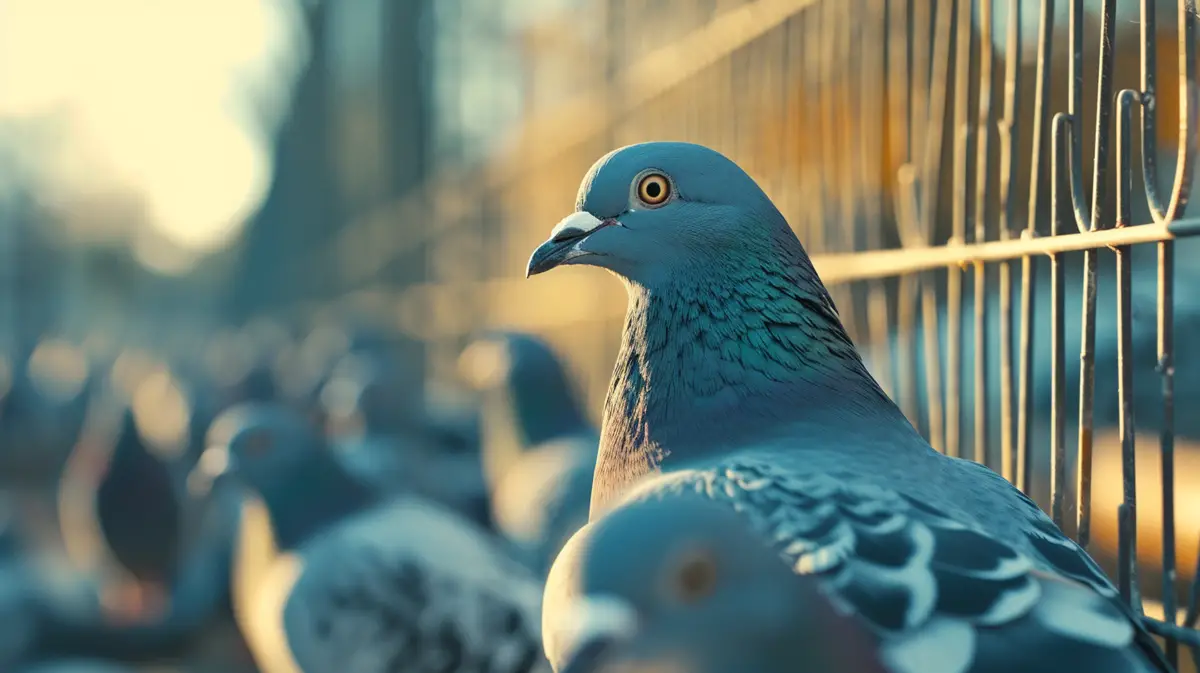Carrier Pigeon Navigation: How Do They Know Where to Go?
Have you ever wondered how carrier pigeons are able to navigate their way back home from miles away? It’s a fascinating phenomenon that has puzzled scientists for centuries. As an expert in the field, I’ve delved into the mysteries of these remarkable birds and uncovered the secrets behind their incredible sense of direction. In this article, I’ll unravel the mystery and explain how carrier pigeons know where to go with such precision and accuracy.
When it comes to finding their way, carrier pigeons rely on a combination of innate abilities and learned behaviors. These birds have a remarkable sense of magnetoreception, which allows them to detect the Earth’s magnetic field. This internal compass guides them in the right direction, even when they are far from home. But that’s not all – carrier pigeons also rely on visual cues and landmarks to navigate their way back. They have an exceptional ability to memorize their surroundings and create mental maps, enabling them to navigate complex terrains effortlessly.
So, how exactly do carrier pigeons know where to go? In this article, I’ll delve deeper into their extraordinary navigation skills, exploring the science behind their magnetic sense and their remarkable memory. Join me as we unravel the secrets of these amazing birds and gain a deeper understanding of their unique ability to find their way home.
The Mystery of Carrier Pigeon Navigation
Carrier pigeons possess a remarkable ability to find their way home from long distances. It’s a mystery that has fascinated scientists and researchers for centuries. How do these birds know where to go? Let’s explore the fascinating science behind carrier pigeon navigation.

Innate Abilities: Carrier pigeons have a special sense called magnetoreception. It allows them to detect the Earth’s magnetic field and use it as an internal compass. This remarkable ability helps them orient themselves and find their way back home, even when they are released in unfamiliar territory.
Learned Behaviors: Besides their innate abilities, carrier pigeons also rely on learned behaviors to navigate. They learn to recognize visual cues and landmarks in their surroundings. These cues help them create mental maps and enable them to make their way back home.
Memorizing Key Locations: Carrier pigeons have an incredible memory. They can memorize important locations along their flight path, such as bodies of water or distinctive landmarks. Using these memorized reference points, they create a mental route that guides them back home.
Sun and Celestial Cues: Another intriguing aspect of carrier pigeon navigation is their ability to use the sun and celestial cues. By observing the position of the sun and the stars, carrier pigeons can determine their direction and maintain a correct heading.
A Combination of Skills: It’s not just one skill that allows carrier pigeons to navigate; it’s a combination of multiple factors. By integrating their innate magnetoreception, learned behaviors, memory, and celestial cues, these birds have a sophisticated navigation system that helps them find their way back home.
Understanding the science behind carrier pigeon navigation is critical to appreciating the incredible abilities of these birds. Their innate senses, learned behaviors, and navigational strategies work together in harmony, allowing them to undertake long journeys and return home with remarkable accuracy.
In the next section, we will delve even deeper into the fascinating world of carrier pigeon navigation and explore how they can navigate such vast distances. Stay tuned!
The Innate Magnetic Sense
To understand how carrier pigeons navigate such vast distances, we need to explore their incredible sense of magnetoreception. You see, carrier pigeons have a natural ability to perceive the Earth’s magnetic field, and this plays a crucial role in their navigation.
What is magnetoreception? It is the ability of some animals to sense and orient themselves to the Earth’s magnetic field. Think of it as having an internal compass that guides them during their flights.
How do carrier pigeons utilize this sense? Scientists believe that carrier pigeons have tiny magnetic particles in their beaks, which act as sensors for the Earth’s magnetic field. By analyzing the strength and direction of the magnetic field, these pigeons can determine their heading and position.
Research findings have shown that if scientists disrupt the Earth’s magnetic field around carrier pigeons, they often get disoriented and lose their way. This further strengthens the idea that their innate magnetic sense is crucial for successful navigation.

Carrier pigeons’ magnetic sense allows them to create what some researchers call a “magnetic map” in their minds. This internal representation of the Earth’s magnetic field helps them determine their position relative to their desired direction.
The amazing part is that carrier pigeons can navigate even in areas with no visual cues or familiar landmarks. This suggests that their magnetic sense is a primary sense for navigation, complementing their use of visual cues and memorized key locations.
The innate magnetic sense of carrier pigeons plays a vital role in their navigation abilities. By perceiving the Earth’s magnetic field, these remarkable birds can determine their heading and position, even in unfamiliar territories. But how exactly do they combine this sense with other navigational strategies? Let’s find out in the next section.
Navigating by Visual Cues and Landmarks
As a carrier pigeon, I rely on several navigation strategies to find my way back home. One of these strategies involves using visual cues and landmarks in my environment. Let me explain how this works.
When I’m released from a distant location, I take in the scenery around me, paying close attention to distinctive landmarks along the way. These landmarks can be anything from tall buildings to unique rock formations or even patches of forest. By memorizing these key locations, I create a mental map that helps guide me on my journey.
Along with landmarks, I also rely on visual cues to determine which direction to fly. For example, I might follow a river or a coastline, or I might navigate by flying along a mountain range. These natural features serve as visual guides that help me maintain a consistent heading.
But how do I know which direction to follow? Well, in addition to visual cues and landmarks, I also use the sun and celestial cues to determine my direction. I can sense the position of the sun in the sky and use it as a compass to navigate effectively.
By combining these various visual cues, landmarks, and celestial cues, I am able to navigate with remarkable accuracy. It’s like having a mental map that guides me back home, even when I’m released from unfamiliar locations.
Carrier pigeons like myself are skilled at using visual cues and landmarks to navigate long distances. We create mental maps based on memorized key locations and use natural features like rivers, coastlines, and mountains to maintain our heading. Additionally, we rely on celestial cues such as the position of the sun in the sky to determine our direction. It’s a fascinating combination of skills that allows us to find our way home. Stay tuned for the next section, where I will delve into how we utilize the Earth’s magnetic field in our navigation.
The Remarkable Memory of Carrier Pigeons
Carrier pigeons possess an incredible ability to navigate their way home from long distances. One of the key factors contributing to their navigation prowess is their remarkable memory.
These birds have the uncanny ability to memorize key locations along their flight path. They create mental maps and use these landmarks to navigate with great precision. The memorized locations serve as guideposts, allowing them to maintain their heading and make accurate course corrections.
In addition to landmarks, carrier pigeons also rely on natural features such as rivers, coastlines, and mountains to orient themselves. These geographical cues act as reference points, helping them maintain a consistent direction.

But how do these pigeons remember all these details? Their remarkable memory is thought to be a combination of innate abilities and learned behaviors. While their innate magnetoreception helps them sense the Earth’s magnetic field for orientation, their memory allows them to recall specific locations and their spatial relationship with one another.
Studies have shown that carrier pigeons have an exceptional ability to remember key locations. In fact, it has been found that they can remember up to hundreds of specific locations along their regular flight paths. This intricate mental map allows them to navigate with incredible accuracy and efficiency.
The impressive memory of carrier pigeons doesn’t end there. Research has also shown that these birds can remember their home loft even if they have been taken to unfamiliar locations. This means that they can find their way back to their loft even from places they have never been before.
The remarkable memory of carrier pigeons plays a crucial role in their ability to navigate their way back home. Their ability to memorize key locations, landmarks, and natural features helps them maintain their heading and make accurate course corrections. With their exceptional memory, these birds create mental maps that allow them to fly incredible distances with unerring precision.
Unraveling the Secrets of Carrier Pigeon Navigation
Let’s delve deeper into the incredible world of carrier pigeon navigation. These remarkable birds possess an innate ability to find their way back home from long distances. But how do they do it? How do they know which direction to fly and how to navigate across unfamiliar landscapes? The secrets lie within their unique biology and their remarkable memory.

One key factor in carrier pigeon navigation is their magnetoreception. These birds have a special sense that allows them to perceive the Earth’s magnetic field. This natural compass guides them in the right direction, helping them stay on course. It’s like having an inbuilt GPS system!
But magnetoreception is just the beginning. Carrier pigeons also rely on a variety of visual cues and landmarks to create mental maps. During their training and flights, they memorize key locations along their flight path. These mental maps serve as a guide to help them navigate back home with incredible accuracy and efficiency.
In addition to magnetoreception and mental maps, carrier pigeons also use the sun and celestial cues to determine their heading. They have an innate sense of the sun’s movement across the sky, allowing them to align their flight direction accordingly. These celestial cues help them maintain a consistent heading, even on cloudy or overcast days when visual landmarks may be obscured.
What truly sets carrier pigeons apart is their remarkable memory. They can recall their home loft even if they have been taken to unfamiliar locations. It’s as if they have an internal GPS that guides them back to their starting point. This exceptional memory allows them to navigate confidently, even when faced with challenging circumstances.
Carrier pigeons possess a unique set of skills that enable them to navigate vast distances with remarkable precision. Their ability to perceive the Earth’s magnetic field, create mental maps, and rely on celestial cues allows them to find their way home time and time again. Their extraordinary memory serves as the backbone of their navigation system, ensuring they can always find their way back, no matter where they’ve been taken.
Carrier pigeon navigation is a fascinating topic that continues to captivate researchers and bird enthusiasts alike. By unraveling the secrets behind their navigation abilities, we gain a deeper understanding of the natural world and the incredible feats that animals can accomplish.
Conclusion
Carrier pigeons possess an extraordinary ability to navigate their way back home from long distances. Through a combination of innate abilities and learned behaviors, these birds rely on various cues and strategies to create mental maps and find their way. Their remarkable memory allows them to memorize key locations along their flight path, enabling them to navigate with incredible accuracy and efficiency. Even when taken to unfamiliar locations, carrier pigeons can still recall their home loft.
The science behind carrier pigeon navigation is truly fascinating. From magnetoreception to visual cues, landmarks, and celestial cues, these birds utilize a range of tools to determine their direction. Studying carrier pigeon navigation not only sheds light on their unique abilities but also holds potential for practical applications in fields such as technology and transportation.
The ability of carrier pigeons to navigate is a testament to the wonders of nature and the remarkable capabilities of these birds. Their navigation skills have captivated scientists and enthusiasts alike, and further research in this area promises to uncover even more about their incredible abilities.






